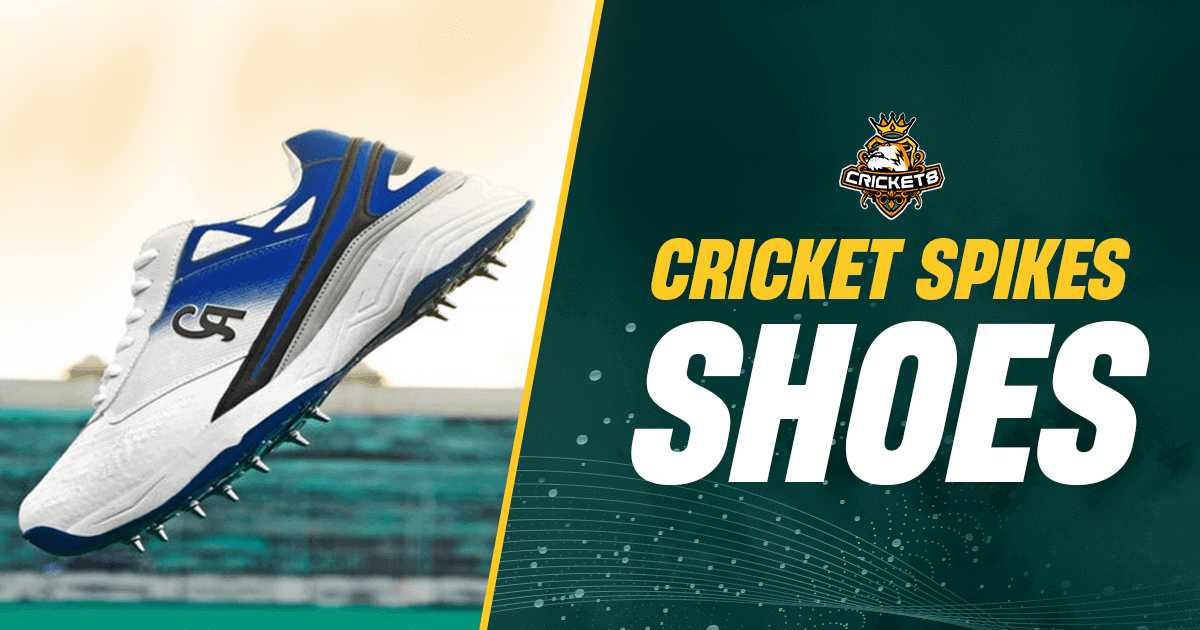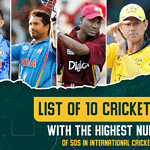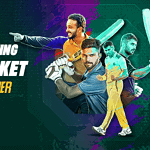
A good pair of Cricket Spikes is an absolute necessity to play at a high level consistently, as they’ll prevent injuries and assist you in performance. Especially if you’re a fast bowler, you need to go onto the specifics on getting the proper Cricket Spikes because to hit the deck hard while bowling fast, you need to make sure that your foot is landing safely. That is what a good cricket spike shoe will ensure.
Just like other cricketing necessities on your kit bag, there should not be compromises in getting cricket shoes because you could have a different size, or your friend could play in half-spike shoes, whereas you are comfortable with full-spike shoes. As we move on, we will extensively discuss the types and importance of finding the right cricket spikes, along with a few other details.
The Purpose of Spikes on Cricket Shoes
Now, you may wonder why spikes are required on my shoes in the first place or why I could just use my jogging shoes or gym trainers for my practice. But, you know, there’s a lot of science behind the purpose of spikes. The core reason behind it all is friction between the surface and the shoe, along with a firm grip.
After nudging the ball into the gap, you are immediately off to take a single or a double. Now, to run as fast as possible, you need to make sure that your shoes have a good grip on the surface and that there isn’t a possibility of slipping because when you’re immediately off to run, your entire backfoot toe pressed backward, pulling the pitch behind, so this naturally would require a firm grip between the surface and the shoe.
The spikes of the shoes will ensure that your feet get firmly attached to the ground, making them not slippery at all. In return, the surface and the spikes cause friction, and as your feet move away from the surface, your foot will generate more traction while maintaining balance due to the higher friction.
Types of Spikes: The reasons behind players choosing different different shoes
Depending on the type of cricket you’ll be playing along with the type of player you are, you need to decide on getting your spikes, and this prioritizes the amount you’d like to be spending as well because the better the quality and the more you’ll be playing, the more expensive Cricket Shoes you need to be getting.
And, depending on the player you are, whether a bowler or a batter or a keeper, you need to get different shoes. Not to mention, if you’re playing an all-rounder or playing in a lower-level cricket, then you could be seeking a round shoe that does both decently.
Stud Boots (Rubber Spikes)
These are the cricket shoes which you’ll buy either if you’re not playing that high level of cricket or if you need to be something temporary. Stud Cricketing shoes are the type of shoes that will have rubber material underneath, which are those plastic spikes that will allow you a basic grip if you’re playing like your local colony tournament.
These cricket shoes are handy if you’re playing on synthetic pitches or mats or in Astro turfs where there is no natural grass or pitch. Get the rubber studs that are light weight and have a mesh design for breathable air. Out of all the boot types, these are the cheapest as you’ll be able to purchase Rubber Cricket Shoes in around 800-5000 rupees range.

Full Spikes
In general, there are around 7-11 spikes in a cricket shoe, depending on the type of player you are and the type you’d prefer. Full Spikes shoes are worn mainly by batters and fast bowlers, especially fast bowlers, given that they need to land their feet firmly after running hard. Shoes are incredibly essential for fast bowlers as often they can prevent them from injuries. And, while Full Spikes shoes, make sure that you get the ones that are swappable. This will make your boots an all-rounder, and depending on the type of game you’ll be playing, you can adjust your shoes. The full spike shoes range from around 3,000 rupees to over 10,000 rupees.

Half Spikes
Half Spikes are the ones that are typically worn by the batters or the spinners, especially the spinners. For the spinners, it is essential that the frontal part of the foot lands firmly. Unlikely fast bowlers, spinners don’t need to have a long run and hit the deck hard, where they may need to go a few steps further to get their balance back. Spinners take no run up to a short run up, where they get the front part of the foot firmly planted on the surface so that they can comfortably bowl.
Similarly, for runners, batters often prefer the forefoot spikes because all of the acceleration they generate from their feet comes through their forefoot, which is why on there the spikes are required on the shoes. So, batters remove the heel spikes and attach rubber studs, which gives them that superior feel. But it’s clearly objective as there are players who prefer full spike shoes for any instance. You’ll see that players like Virat Kohli, Rohit Sharma or Tamim Iqbal all wear half spikes shoes when they’re batting.
The prices of Half spike shoes are similar to the full-spike ones, but given how cricket shoes are now adjustable with swappable spikes to studs, I’d suggest you get the all-round shoes instead of a half-and-half given that you might prefer only studs while fielding.

High Ankle/Neck Shoes
These shoes are primarily for fast bowlers as they have padding up until the ankle or the neck of the foot to give the players extra security and extra cushioning in their ankles as well as comfort. You’ll see many fast bowlers, starting from the Veteran Glen McGrath to the current generation maestros like Mustafizur Rahman, Pat Cummins, or Trent Boult, all of whom use the High Ankle shoes.
If you’re a fast bowler who has a long run-up, hits the deck hard, and is injury-prone, then I’d recommend you get the High Ankle Cricket Shoes. Get the High ankle boots that have a strapping even.

What are the essentials to have along with your Cricket Shoes

Cricket Socks
Cricket Socks are actually quite specific, and more often than not, you’ll see that they come in cream or grey color. Cricket socks are a lot thicker than typical socks, giving you a firm attachment between the feet and the foot. So, make sure you invest in a good pair of cricket socks.
Spanners
Now, when you have Cricket Shoes that have swappable spikes, you need something to open those spikes as they cannot opened or attached through the hand. You require what is known as a spanner. Essentially, it is like a screwdriver for cricket shoes since it attaches or takes out the spikes or studs. So, make sure you always carry one or two spanners in your kit bag.

Spare Spikes and Studs
As I’ve said before, I’d want you to have a pair of shoes that is like an all-rounder. The type of shoes that you can adjust depends on the game you’ll be playing. So, if your team is bowling first and you’re a batter, you prefer fielding without the spikes on, and then when you bat, you choose to have the spikes on. During these scenarios, it is essential to carry spare spikes so that you can use them at your convenience. So, make sure you carry spare spikes and studs with you.

How to Choose Your Spikes
As I’ve spoken before, if you’re a pacer, then you should get the high-ankle, completely spiked cricket shoes.
If you’re a batter or a spinner, then get the all-rounder spike swappable shoes or get the half-spike ones. But, overall, I’d say to own two sets of shoes. One is spike-swappable, and the other one is those high-ankle shoes. But all of these options can also vary depending on your comfort zone, so be sure to experiment on your own as well. And, all that I’ve said is for Unisex Cricket, as quite a lot of information is learned from female cricket content creators and female crickets.
Common Question: Why do I see holes in some of the player’s spikes?
Often, players struggle with the size of the shoes because their feet may have an uneven size that could either fit well with the width of your feet or the length of the feet. So, the holes that you will often see in fast bowlers’ shoes are due to the size of the shoes being longer than the length of their feet.
Due to the gap of the feet with the shoe-toe space, when you’re running hard and stamping your front leg on the ground when you are releasing the ball, due to the gap in your shoe, your toe part of the foot comes forward and constantly clashes with the foot. This is actually a painful experience, given that if you’re bowling 10-30 overs in a test match more than 150 times, your toenails will clash with your shoes. That is, players create a hole in the boots so that when their toes or nails come forward, there’s a gap, making sure that there’s less pain involved. Oftentimes, even batters face this problem since batters also place a lot of pressure on their forefoot, which generates all the acceleration.
Players like Shoaib Akhter, Mohammad Shami, and Mitchel Johnson have all had holes in their shoes while bowling.

To Conclude!
Hence, to grasp it all, investing in the right pair of cricket spikes is crucial for any player looking to excel in the sport. Whether you’re a fast bowler aiming for optimal cushioning and ankle support, a batter seeking superior grip and stability, or a spinner prioritizing comfort and agility, selecting the perfect cricket shoes can significantly impact your performance on the field. With options ranging from full spikes to half spikes and high ankle boots, modern cricket shoes offer cutting-edge designs tailored to meet the specific needs of different players. Additionally, the availability of swappable spikes ensures adaptability to various playing conditions, enhancing overall versatility. When choosing cricket shoes, consider factors such as the upper material for durability, the design for enhanced comfort, and the general construction for maximum performance. By prioritizing the proper footwear, players can minimize the risk of injuries and elevate their game to new heights.




